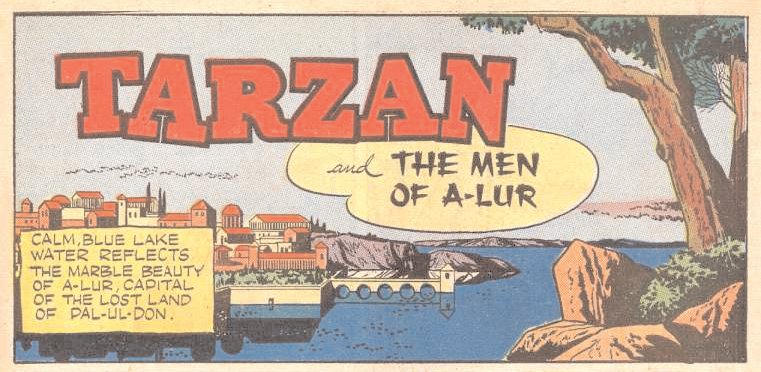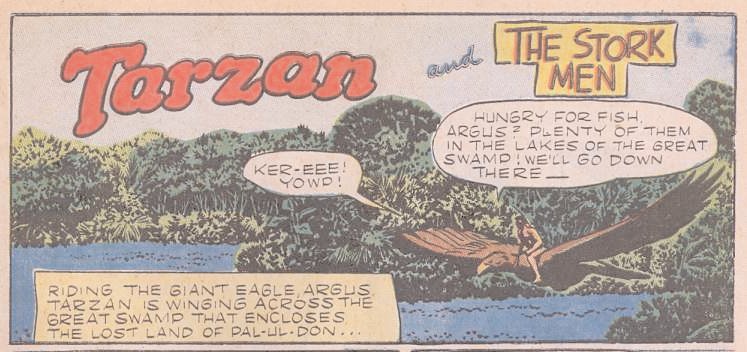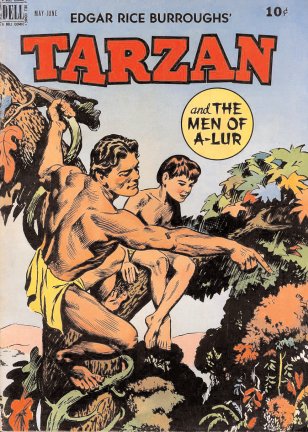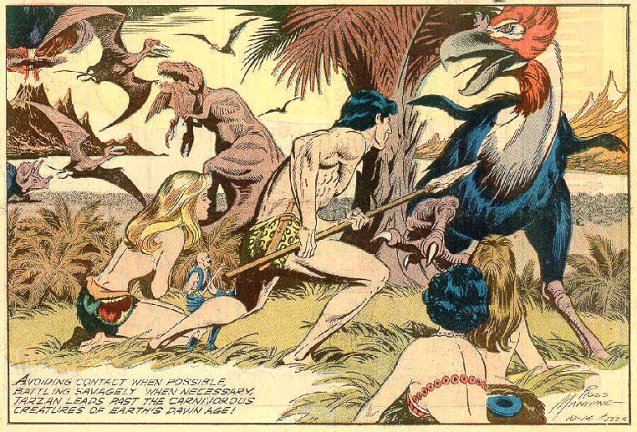
Official Edgar Rice Burroughs Tribute & Weekly Webzine Site
Since 1996 ~ Over 10,000 Webzines and Webpages In Archive
Volume 2804
Searching For The Lost Valley
by Jack D. Elliott, Jr.
Reprinted from Tombigbee Country Magazine



As a child growing up in the 1950s and 60s at Palo Alto, a small hamlet in the prairies of western Clay County, my immediate world, the world of the familiar, was a small cluster of buildings. These included: my home, the family store, my grandparentsís home, the home of my aunt and uncle across the highway, and a number of barns and sheds. Surrounding us were pastures broken intermittently by clumps of trees all of which seemed to extend endlessly across the rolling prairie lands. Crossing the fence from our yard to the pasture was to move from the familiar into an increasingly mysterious world, a wonderland to be explored, a wonderland significantly inspired by stories of lost worlds and forgotten civilizations.I don't remember my first exploration. However my parents on numerous occasions related an event that occurred when I was about two or three years old. I had been left alone playing in our back yard. When my mother later looked for me, she discovered to her horror that I was gone. I had crawled under the fence and wandered off into the pasture passing completely out of sight on the far side of a low hill. After a frantic search my parents finally found me about a quarter mile away beside a pond apparently enthralled with my discovery and oblivious to the fact that anyone was looking for me.
My later explorations were in part stimulated by tales of expeditions to distant and often lost lands as found in books, comics, and movies. These included Jules Verne's
Journey to the Center of the Earth, Arthur Conan Doyle's The Lost World, and H. Rider Haggardís King Solomonís Mines. These stories were available in their original book form along with movie and comic book adaptations, all of which I avidly devoured. In the stories lost worlds were discovered, respectively, in the earth's interior, in South America, and in Africa, each having a variety of dinosaurs or primitive societies. All were protected from the outside world by formidable barriers and could only be entered by those with sufficient vision, will, and courage.
The Tarzan comics were a particular favorite, not so much because of Tarzan but because there was a lost land called Pal-ul-don which Tarzan frequently visited and where he had numerous adventures. Pal-ul-don, like Tarzan, was the creation of the novelist Edgar Rice Burroughs. However, in the comic books the writer Gaylord DuBois and the artist Jesse Marsh transformed Pal-ul-don into something that Burroughs never dreamt of. It became the most fascinating of the lost worlds, something of a super lost world, possessing a great variety of prehistoric beasts and civilizations, all sheltered from the modern world by encircling deserts and swamps.

Tarzan entered Pal-ul-don by passing through the Thorn Desert and the Great Swamp sometimes on foot and sometimes riding his giant eagle Argus. While passing through the Great Swamp he would begin to encounter dinosaurs as the first signs that he was entering a place both strange and wonderful. Pal-ul-don possessed extensive wilderness occupied not only by dinosaurs, but also by woolly mammoths, saber tooth tigers, and other prehistoric animals.The most memorable of the dinosaurs was the triceratops, or gryf as it was known in the language of Pal-ul-don. If a person knew how to go about it a gryf could be controlled and ridden as Tarzan often did. There were also cities built of stone and surrounded by great protective walls. One was A-lur, the capital of Pal-ul-don, while others included Opar, a lost colony of Atlantis; the warring cities of Cathne and Athne; and Lutor, a kingdom located on islands in the Great Swamp. The Lutorians were constantly subject to attack by the swamp-dwelling Horribs, men dressed in crocodile suits and riding giant lizards called gorobars.
These images of a lost land waiting to be explored inspired my imagination and my activities. Whenever a friend would spend Friday night with me I would begin organizing an expedition for the next morning. This entailed filling our canteens with water and a knapsack with lunch usually consisting of items from my father's store, such as sardines, potted meat, crackers, and hoop cheese. After these preparations were made we would set off.
North of my house the pastures and woods extended for miles without being crossed by a road. This was terra incognita, unknown land. I knew the first half mile or so quite well, because it was our land. However, toward the northern reaches of our property the land dropped off into a broad valley sheltered from the sight of the highway to the west by a high escarpment which gave the valley an aura of remoteness. On the hill overlooking this "Lost Valley" there was an old hand pump where a house had once stood. The pump was like the last outpost of civilization before we entered the wilderness. We would often pump the water, sometimes mixed with flecks of rust, and have a cool drink before descending the hill, crossing a fence, and entering the Lost Valley.
On one early expedition I discovered gullies eroded into the underlying chalk, or "lime" as we called it, exposing fossils 70 million years old from the Age of the Dinosaurs. Although most of the fossils were shells of extinct oysters, many of enormous size, I would occasionally find bones of marine reptiles and shark teeth. I was utterly enthralled by the quantity of fossils; there were thousands! This chalk outcropping became a gateway to the time of the dinosaurs, and I would spend hours walking through the gullies looking for fossils, especially for the especially rare bones of reptiles. If I was accompanied by someone Iím afraid that they often became bored by my tenacious searching. Consequently, I usually had to return alone as I did on many occasions. As I passed through the surrounding profusion of secondary growth and tall weeds, I envisioned it as the Great Swamp that encircled Pal-ul-don, while the chalk outcropping itself, with all of its evocations of a prehistoric world, became Pal-ul-don.
On another weekend my friend Ike Lee and I determined to travel beyond the outcropping into the heart of the Lost Valley, crossing yet more property lines, and entering new worlds. For our expedition we assumed the identities of Sir Walter Raleigh (Ike) and Sir Francis Drake, fancying ourselves to be great explorers. Besides our lunch we carried with us paper and pencils to map what we found. We began at a very small dry creek or ditch not far from Pal-ul-don which we named the "Drake River" after my alternate identity. After considerable hiking we came to another "river" of comparable size that flowed into the Drake; it was named the Raleigh River. The "river" formed by the confluence of the Drake and Raleigh was given a combination of the two names, the "Drakeleigh." We continued northwards along the Drakeleigh River into yet another pasture and then another until weariness finally forced us to turn back toward home. We never managed to cross the Lost Valley in its entirety.
In the early 70s I began to see the land in a different light as I became more attuned to the recollections of its older inhabitants and discovered a wealth of records in the courthouse that provided insights into the history and places of Palo Alto. In this case the most familiar of all places, my own home, acquired a sense of strangeness as the setting for events of long ago. I would later go in pursuit of other lost settlements such as the extinct Tombigbee River towns of Cotton Gin Port, Colbert, Barton, and Waverley and early forts at Natchez, Cotton Gin Port, Plymouth, and St. Stephens and eventually pursue the mystery of place all the way to the Middle East and the Holy Land.
As we go through life, if we allow it, the world can become commonplace. We pass by houses and stores, countryside and towns, roads and rivers barely noticing. However, if we are open to it, the world can be seen as far more mysterious and exciting than we usually realize.
The stories of my childhood and youth stimulated my imagination and allowed me to see the land in very different ways. I intuitively realized that the land and its history involved more than what I actually saw; indeed it had a theological dimension. I came to realize through observations such as those of the Catholic writer and author of The Lord of the Rings, J.R.R. Tolkien, that it is through stories of the imagination that we learn to discern "the wonder of all things" and see "things as we are (or were) meant to see them." We become aware of the order and the beauty and the very existence of creation. Rather than something commonplace we can see creation as the tip of an iceberg where the seen points to the unseen, the immanent to the Transcendent.
Even now I can stand overlooking the Lost Valley with cows grazing far off in the distance and remember imagining a lost land like Pal-ul-don out there. In the bellowing of a cow I can almost hear the bellowing of a gryf -- somewhere beyond the Great Swamp.


![]()
WEB REFS FROM ERBzine
The ERBzine ERB Comics Encyclopedia
Read the Dell Tarzan
Comics
Read Duane Adams' Dell
Tarzan Comics Reviews and Summaries
The Geography (physical
& cultural) of Pal-ul-don
Read Tarzan the Terrible
in e-Text
Tarzan Returns to
Pal-ul-don by Russ Manning
Tarzan and Jane in
Pal-ul-don by Russ Manning
Tarzan's Pal-ul-don
Adventure Continues I by Russ Manning
Tarzan's Pal-ul-don
Adventure Continues II by Russ Manning
![]()
![]()
![]()
![]()
![]()

![]()
BILL
HILLMAN
Visit
our thousands of other sites at:
BILL
AND SUE-ON HILLMAN ECLECTIC STUDIO
ERB
Text, ERB Images and Tarzan® are ©Edgar Rice Burroughs, Inc.-
All Rights Reserved.
All
Original Work ©1996-2009/2010 by Bill Hillman and/or Contributing
Authors/Owners
No
part of this web site may be reproduced without permission from the respective
owners.